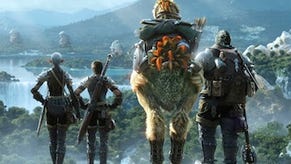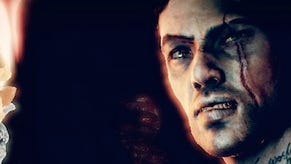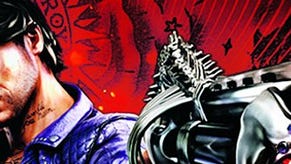Suda's Hell - Shadows of the Damned's GDC demo
Suda 51's working on a new project. We saw it at GDC. For some, that's everything you need to know. For everyone else, here's this feature.
There are many words that could be used to describe the enigmatic, unabashedly toilet-obsessed Suda 51. “Normal,” however, is one that you ought to toss down that ol' porcelain throne. In a time when big-budget game development has become a competition of close-minded oneupmanship, Suda's shown zero restraint in fearlessly diving off the deep end – for better or worse. You can't, however, fault the man for trying, especially when the results include a wheelchair-bound assassin with multiple personality disorder and a beam katana-wielding nerd who's everything Star Wars kid wished he could be.
Suda's always had one stumbling block, though. His idea's are pure gold, but his execution's typically less diamond and more rough. Enter Shinji Mikami. While undeniably brilliant, the Resident Evil and Vanquish creator has generally been able to keep his ideas more grounded and functional. On paper, then, a meeting of these two minds is a match made in heaven. And from what we saw of Shadows of the Damned, there aren't too terribly many reasons to doubt that assertion.
Garcia's Inferno
Shadows of the Damned casts you Garcia Hotspur, a tattoo-covered tough guy braving the depths of hell itself to save his girlfriend from the evil Flemming. Lest you fear that Suda and Mikami are simply making the game you liked better when it was called “Dante's Inferno,” however, know that Shadows has about as much in common with that game as it does with Angry Birds. Most noticeably, the game really doesn't take itself seriously at all. It's gross, ridiculous, over-the-top, and grindhouse-y, giving birth to wonderful exchanges like:
“Everyone in hell is damned. The VIPs just get perks.”
“Such as?”
“They get to keep their genitals.”
Other hits included a surprisingly comprehensive discussion about how all strawberries are actually ground-up human tongues. Really, the morose banter between Garcia and his demon-turned-talking-gun Johnson was one of the biggest highlights of the demo we saw. Garcia's hell-bent, hell-destroying attitude was nice and all, but Johnson completed him. Speaking in a timid-yet-polite British accent, Johnson was comically out of place in Suda and Mikami's imaginatively gothic vision of hell. But that's why he worked – though we do have to wonder why he was so frequently cowardly (to great effect, mind you) when he's, you know, a transforming gun.
In the demo we saw, Johnson could take many different upgradable forms, including handgun (given the thematically appropriate name of “The Boner”), machine gun, and shotgun. Keeping with that idea, ammo came in the form of skeletal parts – skulls, teeth, bones, etc. Meanwhile, if Garcia needed health, he just chugged some alcohol.
None of which is entirely revolutionary, mind you, but small touches like those gave the game a unique vibe that separated it from the rest of the pack. And while Shadows' humor certainly tended toward the gutter (really though, this is hell; what else do you expect?), it had a gleeful sense of self-awareness – as opposed to the oddly boisterous self-consciousness present in similarly vulgar games like Bulletstorm. Put simply, Shadows knows what it is: schlocky, grindhouse-inspired fun.
Hell is (trying to find) other people
When it came time to stop talking and start shooting, Shadows of the Damned reminded us very much of Resident Evil 4, but on some strange illegal substance. Something that packed a punch. Something that'd drive lesser men completely mad. So, you know, Suda 51. The camera once again hovered in a familiar over-the-shoulder position, and Garcia was forced to tussle with a small crowds of both fast and slow-moving zombie-like enemies. Again, though, little touches helped to really define the game's identity. For instance, a double headshot (two birds, one stone) was rewarded with a slow-mo zoom in on the carnage.
The game also distinguished itself with a heavy focus on light and darkness. Simply looking at the game's environments, one could see plenty of muted blacks, blues, and reds sprinkled across the game's dilapidated Eastern European architectural sensibilities, but that was only the tip of the iceberg. Darkness was also a central gameplay mechanic, with thick, sludgy waves of blue goop frequently enveloping the player and nearby enemies. Garcia, then, had to stop the darkness at its source, which oftentimes took the form of terrifying wall-mounted goat heads or disembodied hands with giant, goop-spewing cuts running right down their centers. (As a sidenote, it really can't be emphasized enough how downright bizarre most of the game's imagery was. Suda, you need help. But please, never get it.)
Suda, you need help. But please, never get it.
In case you hadn't guessed, the darkness was a bad thing – primarily for two reasons: 1) It slowly damaged Garcia, and 2) it made enemies invincible. Even after blasting whatever insane Suda nightmare vision was barfing the stuff out, however, battles were far from finished. Many enemies, in fact, still dripped with darkness, which could be removed with either a melee attack or a specialized light shot from Johnson. After that, however, bullets tore through flesh and bone like a hot knife through butter, even popping off limbs ala Dead Space.
You must be this tall to ride
Based on what we saw, Shadows of the Damned also looked to be quite linear, although not to any spectacular effect. The game did, however, show off its fair share of cut-scenes, with one depicting Garcia's girlfriend strolling right up to her would-be knight in shining armor out of nowhere. We believe a certain Admiral Ackbar would probably have something to say about that, but as is, we'll let the game speak for him. Which is all to say, HOLY S**T, THAT WOMAN JUST TORE OFF HER SKIN.
Nice as it would've been for Garcia if things really were that easy, it – of course – turned out to be a giant green monster in a Garcia's girlfriend disguise. Wait, “of course”? What are we saying? We practically leaped out of our skin when the monster tore its own in two – which goes back to Suda and Mikami's general philosophy toward the game. It's not a traditional horror game, they said, so there are no cheap scares or boogie men waiting around corners. Instead, Shadows of the Damned is grotesque, in-your-face and, well, weird. Really, really weird.
Before long, the green, not-so-gentle giant pounced, and Garcia had to dodge about as the beast charged at him like a bull. In all honesty, however, there wasn't much to the encounter, as the enormous red weakpoint on the monster's back was pretty obvious. All told, it was a fairly underwhelming fight, but it also seemed relatively early in the game, so here's hoping for something a bit more climactic in the game's later stages.
No more heroes, but many more questions
All told, Shadows of the Damned looked damn promising, but nothing about it really blew us away. Don't get us wrong: the shooting seemed frantically fun and we totally dug the game's attitude. However, combat mostly consisted of extinguishing darkness, blasting relatively weak baddies, and then repeating that pattern through a series of artistically brilliant (though unremarkably designed) linear levels. The game's got more character than most entire genres, but at this point, we're still not entirely sold on its mechanics. There is, however, tremendous potential swimming around beneath the surface, so here's hoping future showings let that potential rip off its boring human skin disguise and reveal whatever hideous, grotesque, amazing creature lurks underneath.












